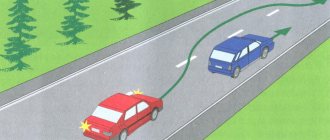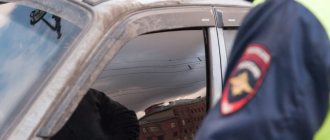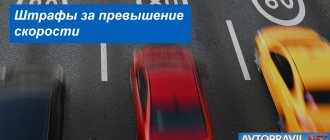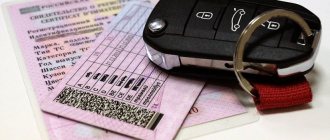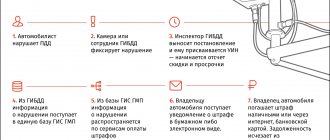Home / Vehicles
Back
Published: 04/10/2020
Reading time: 2 min
0
590
- Hello. Is there a clause in the Rules of the Road that prohibits overtaking or avoiding obstacles if the vehicle in front is overtaking or avoiding the obstacle? Does “overtaking a train” threaten with deprivation of your license? Which car is prohibited from overtaking according to the rules: the one that is overtaking, or the one being overtaken?
- What do the Traffic Rules say about overtaking a train?
- Is it possible to overtake with a train?
- Responsibility for non-compliance with the rules
Understanding the concepts
Before you announce the fine for overtaking a train, as well as for double overtaking, you should understand what this means.
Double overtaking is considered to be overtaking 2 or more vehicles by driving into the oncoming lane. That is, during such a maneuver, having gotten ahead of the first car, the driver does not return to his part of the road. Or overtaking a car that is overtaking at that moment is considered as such.
But there is also the concept of being overtaken by a train. Also called gooseneck. In this case, you drive into the oncoming lane behind the car that is overtaking. At this moment, there are 2 or more cars on the opposite side of the road.
There is a whole section in the current traffic regulations regarding overtaking. All the rules for safe maneuvers, existing prohibitions, as well as the conditions under which overtaking is possible are spelled out here.
The punishment does not follow for the fact of overtaking. The question here is about entering someone else's lane.
Yes, in theory, when overtaking you always need to drive into oncoming traffic. But not always, when driving into the oncoming lane, the driver overtakes. Sometimes this is an advance, as in the case of overtaking slow-moving vehicles, which were already discussed earlier.
And overtaking in dangerous turns is always prohibited. There are no conditions that allow such an action to be performed without violating the rules.
Let's talk about double overtaking
The traffic rules contain prohibitions and regulations regarding such a maneuver. It turns out that when there are no prohibitions, then it is allowed.
The current traffic regulations for 2021 do not contain any clauses prohibiting double overtaking. Moreover, regardless of the number of vehicles taking part in such a maneuver.
There is only one condition. Drivers are required to make sure in advance that their actions will not entail any dangerous consequences. That is, the maneuver is safe.
The conclusion about whether a maneuver is safe depends on the consequences. If no accident occurred, then everything was done according to the rules. If an accident occurs, you will have to pay a fine or lose your license.
But clarifications need to be made. According to traffic rules, when performing the action in question, drivers are required to check several points:
- there are no cars in the oncoming lane, or they are at a sufficient distance to have time to complete the maneuver;
- there is no continuous dividing strip ahead;
- there is no sign prohibiting overtaking;
- there is no overpass, pedestrian zone, or railway crossing;
- the same applies to tunnels, overpasses, dangerous turns and climbs;
- at that moment the car behind did not overtake your vehicle;
- None of the cars in front activated their left turn signal.
This list fully defines the conditions under which it is and is not possible to overtake and enter the oncoming part of the road. The same applies to the double type of maneuver.
Now about overtaking by a train
Here the situation is somewhat different. And it needs to be considered separately.
Let us remember that here we are talking about a maneuver in which your car and at least one other car began to overtake another car, moving one after another. A kind of column.
Plus, there is the concept of overtaking a car that is already overtaking. Imagine the situation. There is a slow car in the lane ahead. You are moving faster. On the left side, the front car began to overtake other vehicles. At this moment, you also pressed the gas, turned left, turning on the turn signal. And now the most important thing. You drive out even further to the left of the car that has started to overtake. And as a result, go around 2 cars at once, one of which also overtakes the other vehicle. It may sound a little confusing, but everything should be clear.
And such a maneuver is considered prohibited.
There are just some nuances. Such an action in the form of a train or a jib is prohibited only by the machine that created the similar effect. That is, there is conditionally the first car that turned on the turn signal and pressed the gas. If all the conditions described above are met, such actions are not considered a violation.
But if there is a line behind this car, and they also turn on the turn signals and press the gas, then the effect of a train is already created. All cars behind you are breaking the rules.
The difficulty is that proving your innocence, even if your vehicle was the first in the created locomotive, is problematic. The only compelling argument will be the video recording from the recorder.
Clause 11.2 of the current rules states that drivers are not allowed to overtake if:
- the vehicle in front is overtaking or driving around an obstacle;
- the car behind began an overtaking maneuver.
It turns out the following. The inspector saw that your vehicle was in front of the conditional column (train). In theory, it's not your fault. But this is in theory. In practice, the inspector could not see that you did not enter the oncoming lane at the moment when another vehicle had already entered the maneuver.
Taking this into account, it is not at all impossible that a driver who seems to be acting within the rules will not be fined or will not be attempted to have his license revoked.
Overtaking single file or train
Overtaking in single file or by a train, when several cars are overtaking a vehicle at once, is prohibited, since the vehicle moving in front is overtaking - clause 11.2 of the traffic rules. The logic is clear - cars in front can block the oncoming lane from view, and the driver is not able to comply with the requirements of clause 11.1 of the traffic rules, that is, he is not able to determine whether the oncoming lane is clear at a distance sufficient for overtaking or not.
The subtlety is that clause 11.2 of the traffic rules describes the prohibition of overtaking where visibility is limited by circumstances. And here is the key difference from paragraph 11.4 of the traffic rules, since it prohibits overtaking in areas with limited visibility - see Restricted visibility.
I highlight once again: clause 11.2 – circumstances prohibiting overtaking, clause 11.4 – areas where overtaking is prohibited.
To establish visibility restrictions on a section of the road, special techniques and special devices are used by specially trained people. The result of the work is an objective determination of the fact of visibility restrictions on a given section of the road with the subsequent installation of appropriate signs. It is impossible to challenge overtaking in a place where visibility is limited.
The circumstances of visibility limitation are established subjectively , and it is difficult to establish the certainty of the violation.
You can say it differently. Traffic regulations provide the driver with many rights, for example, the right to determine the number of lanes for traffic in the absence of signs or markings - clause 9.1 of the traffic regulations. Paragraph 11.2 of the traffic rules gives the driver the right to subjectively determine whether overtaking is safe or not if someone in front is already overtaking.
Apparently, this point was taken into account by the Supreme Court in PPVS No. 20. Compare the two wordings yourself - from the SDA and from the PPVS:
“The driver is prohibited from overtaking in cases where the vehicle moving in front is overtaking or going around an obstacle,” - clause 11.2 of the traffic rules.
“It is not allowed to overtake a vehicle moving in front that is overtaking or going around an obstacle,” - paragraph “g”, paragraph 15 of the PPVS No. 20 of June 25, 2019.
It is immediately clear that according to the traffic rules, both overtaking an overtaking person (“double overtaking”) and overtaking “in single file” are prohibited. And according to PPVS - only “double overtaking”. Overtaking an overtaking person is an objective fact, overtaking in single file is a subjective fact. See further Evaluative Concepts.
It is important to understand that clause 11.2 of the traffic rules prohibits single file overtaking of the same vehicle. If there is another truck in front of the truck that you are going to overtake, which your colleague is trying to overtake, then the oncoming lane in front of him is clear at a distance sufficient for overtaking. This is a signal to you that you can overtake - the oncoming lane is clear at a distance sufficient for you to overtake. That is, as mentioned above, you are able to fulfill the requirements of clause 11.1 of the traffic rules, which, by the way, does not say anything that the driver must visually verify whether the oncoming lane is clear or not.
Conclusion: compliance with the requirements of clause 11.2 of the Traffic Regulations should always be considered in conjunction with compliance with the requirements of clause 11.1 of the Traffic Regulations.
It is more correct to refuse to overtake in single file not because of limited visibility, but because the driver becomes dependent on other drivers who are overtaking ahead or behind. Imagine that the person in front has completed overtaking, but instead of moving forward, he began to brake, not giving you room to return to your lane. While you are wondering what is going on, he turns left. Who is guilty? You! Since at the beginning of overtaking you were not convinced that at the end of overtaking you will be able to freely return to the previously occupied lane - clause 11.2 of the traffic rules.
0
Author of the publication
offline 12 hours
GarryB83
0
Comments: 0Publications: 1252Registration: 07/17/2018
Possible penalties
See also
Towbars Trailer: buy, install, certificate, reviews
Reminds that there are no penalties for overtaking actions as such. And it doesn’t matter whether it’s a double or a train.
The fact is different. Any such action is often interpreted according to Part 4 of 12.15 of the Administrative Code. And here we are talking about a fine or deprivation of rights for driving into the oncoming part of the road in violation of the rules. There is also an article following it, where the punishment will be much more serious.
As a result, there are 3 possible punishment options. It all depends on the specific situation:
- The driver drove into the oncoming lane, violating traffic rules. Interpreted according to Part 4 of Article 12.15. Here, at best, you will have to give 5 thousand rubles to the state treasury. In the worst case, the driver will find himself without a license for a period of 4 to 6 months;
- The motorist repeatedly violated the previous rule. In theory, you can pay 5 thousand rubles again. But provided that the violation was recorded using a special camera. But there is a more unpleasant outcome. This is deprivation of a certificate. Only now for 1 year;
- The driver was forced to drive onto the oncoming side of the road to avoid the obstacle. And no one will worry that the side of the road on which the driver should eat turned out to be unsuitable for this. Or some other obstacle has arisen. If you left, then be kind enough to pay from 1 to 1.5 thousand rubles.
Now you know about possible liability.
Yes, if the inspector or traffic cameras did not record a violation, then it would be as if it never happened. But this is not a reason to make downright dangerous maneuvers.
What is overtaking by a “locomotive”
According to traffic regulations, simple overtaking is the act of getting ahead of one, two or more vehicles, for which the driver needs to move into the lane intended for oncoming traffic. Completion of the maneuver always occurs by returning to your half of the road.
Overtaking “locomotive” or “in single file” is the execution of an advance by entering the oncoming lane, which is carried out simultaneously with another car in front. As a result, two or more vehicles find themselves in the oncoming lane at the same time.
Is the maneuver allowed?
In order to understand whether it is permissible to perform such a maneuver or not, it is worth studying section 11 of the Traffic Rules. It states that entering the left lane intended for oncoming traffic is prohibited under the following conditions:
- The car in front avoids obstacles or slowly moving vehicles.
- The car you plan to overtake has its left turn signal on.
- A vehicle moving behind has already begun to perform a similar maneuver.
- The current traffic situation will not allow the overtaking person to safely return to his lane upon completion of overtaking.
From the analysis of the listed points, it becomes clear that the traffic rules contain an unambiguous prohibition on overtaking in single file. It is possible to carry out such an action only in the absence of other vehicles moving in the same direction in the oncoming lane.
Responsibility for violations of the rules
Violation of the rules for maneuvering on the roadway is punishable under Article 12.15 of the Code of Administrative Offenses of the Russian Federation. According to subparagraphs 3, 4 and 5 of this norm, the following penalties are provided for violators:
| Did not find an answer to your question? Call a lawyer! Moscow: +7 (499) 110-89-42 St. Petersburg: +7 (812) 385-56-34 Russia: +7 (499) 755-96-84 |
- driving into the oncoming lane while performing a maneuver - 5,000 rubles if the violation is recorded using a camera or deprivation of a driver’s license for a period of 4 to six months;
- a similar offense committed repeatedly – a fine of 5,000 rubles if recorded by a camera or deprivation of the right to drive a vehicle for 12 months;
- incorrect detour of an obstacle (this article is used extremely rarely by traffic police inspectors) - a monetary penalty in the amount of 1000 to 1500 rubles.
Overtaking with a “locomotive” is one of the most common maneuvering techniques on country roads. Unfortunately, most drivers are not aware that traffic regulations contain a direct prohibition on performing this action. The reason for such restrictions is the high risk that accompanies such maneuvering and the likelihood of an emergency.
